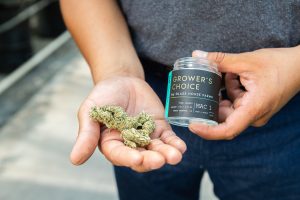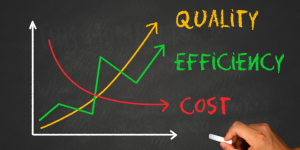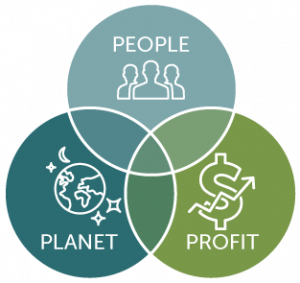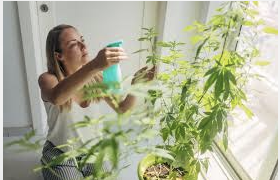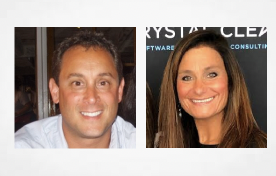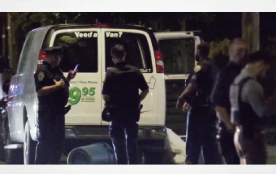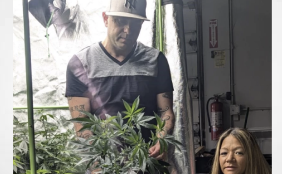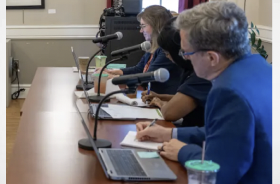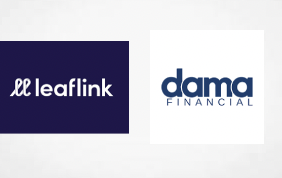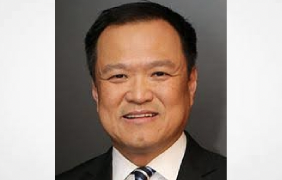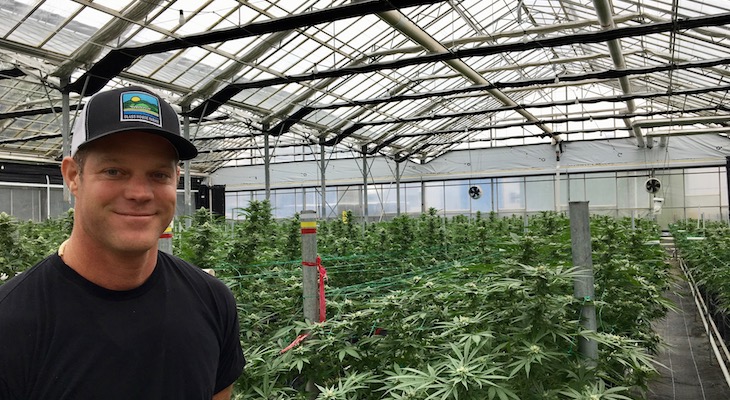Graham Farrar is the president and Chief Cannabis Officer of Glass House Group, one of the most rapidly growing, privately-held cannabis and hemp companies in the U.S., and the founder of Glass House Farms, the largest greenhouse operation in the U.S.
If you wish to re-publish this story please do so with following accreditation
AUTHOR: Heather Allman
PUBLISHER: CANNABIS LAW REPORT
Taming the Beast: Interview with Graham Farrar of Glass House Group
The “Beast” in this scenario is cannabis sustainability, and the distinct lack thereof. The market for change is wide open, and here’s the perspective of one man and the vision of one company who is getting an edge in the Cannabis sustainability market.
Graham Farrar, Glass House Farms
Graham Farrar is the president and Chief Cannabis Officer of Glass House Group, one of the most rapidly growing, privately-held cannabis and hemp companies in the U.S., and the founder of Glass House Farms, the largest greenhouse operation in the U.S.
He was part of the original team at Software.com, taking the company public in 1999, and one of the first employees at Sonos, where he was involved with product design, development, sales and customer support.
With 25 years of experience in the technology sector as well as in starting successful businesses in new and emerging markets, Graham has now created one of the largest earth-friendly cannabis and hemp businesses in the country, with a cutting edge water reclamation system and other industry-leading technologies.
His sun-grown and ocean-grown operation is viewed as a model for tech innovation, sustainability and financial success in the cannabis space.
On November 24, 2020, I had the opportunity to interview Graham Farrar of Glass House Group, and we discussed 2020, the future of cannabis sustainability and renewability, challenges, and what’s next for him and Glass House Group.
CANNABIS LAW REPORT: You grew up in Santa Barbara, but how exactly did you get into the cannabis space and form Glass House Group?
Graham Farrar: That’s a great question and it’s kind of a serendipitous, at least from my perspective, a serendipitous story.
Santa Barbara is my hometown —it’s the combination of the things I love, which are cannabis technology, building something new, and sustainability.
I’m working in my own backyard, so I have to pinch myself that all this happened, because who would have ever predicted 20 years ago that Santa Barbara would be a hotspot for cannabis cultivation in California?
I grew up here in Santa Barbara, and I’m actually kind of a tech geek by training and background, but have been a longtime lover of cannabis. I’ve been playing around with cannabis for probably 25 plus years —everything from grows, Prop 215 stuff, and other aspects.
I think Cannabis is a great thing for society, and I think the world’s a better place with cannabis in it. It’s certainly better than the prohibition mindset the U.S. has been operating in for decades.
Now, we’ve been in a regulatory mindset and we shouldn’t return to the default plan we’ve had for years in this country. We shouldn’t be tearing apart families and communities over a plant —a plant that isn’t bad, but rather, in many ways, a plant that is and can be a positive thing.
All that aside, I’ve always loved cannabis. I’ve always thought it was something that made the world a better place. Technology is my background.
Today, though, from my current perspective, I really see where California is similar to one of my favorite Martin Luther King Jr quotes –which says “the moral arc of history is long but it bends towards justice,” and it looks like we’re finally getting closer to justice, with respect to cannabis.
Luckily for us, they have fantastic greenhouse infrastructure and the climate in Santa Barbara is perfect for growing cannabis.
We initially set out under Prop 215 to start our first farm, which was 150,000 square feet —and it’s still pretty big— but at the time, half a decade ago, that farm was gigantic. Consequently, we spent a lot of blood, sweat, and tears putting that together.
We did the same when starting the second farm —which is 350,000 square feet— so between the two, we have a half million square feet fully up and running. In fact, it was the first fully licensed farm in Santa Barbara County, and it’s still one of the very few truly, fully permitted farms here.
Then we opened The Farmacy, which is the first dispensary ever in the city of Santa Barbara. We put all those pieces together to form Glass House Groups, so now we are four dispensaries and four brands.
Glass House Farms Field Extracts is a really cool extra brand of forbidden flowers, which is a health and wellness brand we created with both Darren Manasu and Sue Taylor, who is a seventy year old, African American woman. Both individuals have unique experiences and perspectives.
We are playing into a very different demographic than most people in the space are paying attention to. We have four stores: one here in Santa Barbara, one in Berkeley. And we have two down in LA, and then a manufacturing lab and our farms.
CLR: What is the mission and vision behind Glass House Farms? How does it align with your personal mission?
GF: Even though we’ve dialed into a vast group of cannabis consumers, and actually, we are some of the first to bring the best agricultural practices to cannabis, and we are doing it in a way where it hopefully amplifies the cannabis industry.
We want to remember love for the plant, and that whether you have one plant or six plants in your hand, why wouldn’t you want to keep that love and respect for the plant and the planet and all that, but then scale it up and amplify it.
I think even technology is one of the best ways to do that. If you think about something as simple as watering your plants. It used to be that you had to show up on time, or worry about when you could or should water supplies, and your hand-watered them.
At Glass House, we get five really smart people together — some cannabis experts. Some agronomists, some agriculture people, and we figure out exactly what the plant needs at each stage of their life and by strain, and then we can program that into a computer, so that computer does exactly what we would do ourselves, 24 hours a day, seven days a week.
It’s just right, every time, it’s right, and what that actually produces is more efficiency, which means we can do half a million square feet of plant watering instead of only 500 square feet.
It’s better because the computer never sleeps, and does really cool stuff like say ‘hey, you know, 20% more sunlight today than than was expected. We’re going to get 20% more water, because the plant is going to be able to photosynthesize,’ so we’re not going to miss out on that extra growth or potency at Glass House.
Likewise, if it’s a foggy day, we’re going to give the plant some percentage of less water —because if we give it the amount of water we normally would, it would just be wasted and so we’d be wasting.
We like to think of a triple bottom line always, which is (a) good for the planet, (b) good for our business andemployees, and (c) good for the customers.
So, in that example, if you give a plant more than it can use, you’re just wasting, right? You’re wasting water and you’re wasting fertilizer.
With our system, you get a really efficient system —which is that you’re getting the absolute most from the plant and you’re going to do it as efficiently as possible: good for the business and good for the planet and good for the customer.
If you bring all those things together, and do it consistently, you’ll succeed.
Quality, consistency, and efficiency are kind of our three taglines.
If you do that and if do it well, you’ve got to do it consistently all the time — and you’ve got to do well, do it efficiently.
CLR: I agree, 100%. I think that quality, efficiency, and consistency are the cornerstones of the cannabis market. I think that, as you said, quality doesn’t have to be sacrificed anymore for scale. That sounds like something you’ve dialed into very well with that type of computer programming.
GF: Yes. If anything, I think we should be able to increase quality. There is nothing inherent about scale that makes you do something less ‘good,’ right?
So I think when we say ‘efficient,’ I always like to point out that we don’t mean efficiency from like an uncaring, factory production line churning out cheap plastic parts, for example.
We mean efficiencies from the point of view that we can give the consumer the best quality cannabis for the best price —that must be factored into the price for consumers.
It means that we can actually give a fantastic product at an amazing price at the same time, yet still keep a business that allows us to treat our employees well and grow, and all the things that the business side wants to do to keep being able to do a good job.
CLR: So, I would assume then that you would agree with the statement that affordability and accessibility go hand in hand, all the time.
GF: Yes, and I mentioned to you how I think the world is a better place with cannabis, and whether that means that you’re using it as medicine for PTSD, or Parkinson’s, or epilepsy, you know, anything.
Or if you’re using it as self-medication, or it helps you sleep better, or relieves arthritis, or just helps you calm down, or even 100% recreationally: I don’t think there’s anything that we need to be ashamed about.
If you have a good time with a joint on a Friday night, that’s awesome too, because there’s really not a downside to it, in my opinion. If you think about alcohol and cigarettes and all the other things that we allow adults to do, I think we should make fair choices all around.
It’s hard to argue that cannabis is not the least harmful of those. So if we can help amplify that perspective, that cannabis is the least harmful, then I think that we want to enable that thought process as much as we can, especially with regulations today —and particularly taxes— that perspective is getting harder to shine a light on, not easier.
By doing things efficiently, we want to be able to bring a product that’s accessible to the widest swath of the market that we can.
CLR: That tells me a lot about your triple bottom line —the “people” part of it— because it seems that you’re very quality-centric at Glass House Group, and you want to bring in those people who aren’t currently experiencing cannabis.
Can you explain a little bit about how businesses could actually become more profitable by incorporating more renewable and sustainable practices.
GF: I’d like to give you an example, because I always get really excited when I see those flushless, waterless toilets.
And the reason I like them so much is because, as a consumer, I don’t have to touch stuff, right? Using those toilets are definitely ‘hands off,’ which is great, from a business perspective.
As a business owner, I would love it because I don’t have to pay a water bill to flush clean water down the drain, even though someone is in the bathroom.
As a person living on the planet, I love it because you’re not wasting about 30,000 gallons per urinal, or whatever it is.
I think it is similar in what we’re doing. I call it ‘precision agriculture.’ And what that term means exactly is that if you give the plant, or any thing in the plant process, more than it needs to do its job, you’re wasting.
So if you over-water a plant, if you use more fertilizer than you need to, if you take more time to grow it than however many weeks are required for the peak quality, then it’s a waste.
Conversely, if you give it less than it could use, you’ve lost something. So if you under-water it, or you don’t give enough fertilizer, or the appropriate environmental conditions, the plant could have given you —given us, given the customers— more than we gleaned from it. This means, ultimately, we lose.
We really try and run with the mindset of having to give the plant exactly what it needs, no more and no less, to get the ideal maximum expression from the plant and be able to sell that and make money — because we know we’re doing business at the lowest possible cost.
So, if you think like that, I think you’re always kind of solving for that triple bottom line, which is
How do we make something that consumers are excited about and how do we give it to them at a price that allows as many of them as possible to purchase it.
We still have a profit margin that allows us to be a business and to treat our employees well. We do a number of other things, like give every employee a minimum of $15 an hour —which is much higher than minimum wage in California— and give everyone health benefits. They have an option that’s no cost to them.
Everybody gets paid sick days, and we don’t really use any seasonal labor, which is pretty uncommon for agriculture.
All of our folks are all full time employees, and some of them have been with us for five years now. We do old school employee appreciation lunches, and lots of things you can only do if you’re running a business sustainably and not wasting.
It’s like: you can’t do that if you’re if you’re going out of business. Why? Because you’re not making the other pieces of sustainability and your intended system work properly. I think the efficiency and bringing things together in sustainability is a piece of that.
If you don’t waste, and figure out how to be efficient, you can make all the other parts of this vision work.
CLR: Tell me about the 2020 cannabis year to date, and take on the current national cannabis landscape.
With COVID-19, what has been the business impact so far for Glass House Farms? Are you as a company doing anything new or differently?
This year has really thrown everybody for a loop. As far as 2020 goes, with COVID, Glass House had to pivot and evolve in light of everything that’s happened this year, but the real answer?
That depends, because we’re one of the few vertically integrated companies, so the answer depends somewhat on the sector or the vertical for us.
For example, retail has very different answers for this question than the farms do. Here in California, the Governor and the state declared all cannabis businesses as essential, so we were never forced to close by mandate of the stay-at-home orders, or anything like that.
Agriculture is almost always deemed essential because people realize that you can’t put a closed sign up on a farm for three weeks and then come back and have anything be there in good shape. Instead, it’s all over, all lost.
So the farm basically kept working. I mean we definitely implemented more safety measures all around, such as:
- We do a lot of vanpooling and carpooling —again to cut down on the resources that we need, and that is a valuable service to our employees because they don’t have to pay for the gas and stuff, but obviously, putting 10 people in a van doesn’t work great in the COVID world, so we had to cancel some of those programs for the continued safety of our employees.
- We also did staggered shifts, so that we didn’t have 100+ people trying to eat lunch in the same area at the same time and so that we can do only 50% occupancy: by doing lunch at two different times.
- In our light and trim rooms that are interior spaces, we put up plexiglass shields between workstations that, again, try and limit unnecessary contact.
- The greenhouses are easy because it’s pretty easy to socially distance in a half a million square feet.
- Everyone’s wearing masks.
- We have two dedicated people who are going around with a sprayable disinfectant to treat any high touch areas, like door handles.
So we’ve got a pretty complex set of behaviors and initiatives that we put in place at Glass House to try and keep people safe, and also, to protect the continuity of the business. All I will say for certain is so far, so good.
We haven’t had any kind of transmission cases that have happened at Glass House, but on the retail side, operations have been running pretty differently too.
So, we stayed open and currently remain open through this whole thing, using our store here in Santa Barbara —which is a small little boutique store, about 1400 square feet— and we actually haven’t had a customer inside the store since March, so it’s employees only in the store right now.
But we turned our entry and exit doors, basically, into teller windows, much like a bank. We now do web orders, pickups, delivery, and they can even help you build an order on an iPad in the parking lot outside, and then they put your order together, and they hand it to you through the teller window —so that we can continue to service people safely, outside, and still do it at a pretty high volume. We also:
- Ramped up our delivery service big time.
- Added six new Prius cars to our delivery fleet, so that we can drop product off at people’s houses.
- Implemented a way so that you can have touchless delivery as well. You don’t have to deal with cash, so you can tap right into your bank account and pay online.
So again, just continually looking for more ways to kind of keep the business continuity going.
CLR: It sounds like you’ve got it really figured out, how to keep helping, keep working. Not only in the ways you just laid out for me, but also in the ways your company had to adjust. It sounds like you’re managing to do a better-than-average job of keeping Glass House continually moving forward.
GF: Then the other great thing, and I feel almost a little bit guilty, I guess, in my thinking that everything that happened with COVID was a huge boost for cannabis from the consumer side.
For example, if your kids came home for spring break in March and they never left, cannabis can be pretty helpful! And we have a lot of new customers and new people showing up daily.
You know, like on the “Tincture on Tuesday” customers versus the “Fun on Friday night” customers —a lot of those are Tuesday people who’ve never been in the store, they come in and we’re all fighting stress. They now want help sleeping and calming down.
We, our sales, you know I think Q3 was one of the best retail quarters we’ve ever had. I think just watching, all the way around, I think Q3 has been fabulous for cannabis.
CLR: How have things evolved, specifically concerning current Glass House Farms initiatives?
GF: I think we hired 60 or 70 people throughout the company since March, so the idea is that we are not laying anyone off and everyone is fully employed, and there’s extra hours available for people if we’re wanting that.
We’re hiring people and paying taxes and just keeping in mind that cannabis is a pretty bright, bright spot against an otherwise bleak economic backdrop. It’s nice to be able to be one of the helpers, in that small regard.
CLR: I agree. I think you are definitely essential workers, that’s for sure.
GF: Well, thank you. In California, we’ve got 24 years now of cannabis as medicine. So, you know, our dispensary in Santa Barbara’s, which is literally called ‘The Farmacy’ spelled with an F like farm, so the idea that cannabis is medicine is something we really believe in.
CLR: Speaking of consumers and evolving, how have the consumers evolved and changed over the last few years?
GF: That’s a good question. Certainly I don’t think we’ve actually really hit him to the ‘middle’ mass market yet. There’s still a vast majority of people who have never stepped foot in a dispensary! Often, it’s easy for us in this industry to forget that, but we really build our dispensaries for the person who’s walking in the door for the first time.
We will also cater to the person who knows exactly what they want, of course, and they want to talk about all the details. As a brand, you want to be able to have the right conversation with each of those people because they both deserve to be served at their level.
So we really build around that, but we are always directly acknowledging that probably 95% of the people that come into one of our stores are in a dispensary for the first time. So, ultimately, we want to be approachable and educational above all.
I’ve always said people who think they don’t like cannabis just don’t know how they like it, which sometimes means they’ve been over-served, particularly in edibles. Sometimes it means they’ve never experienced anything besides two buds in a ziplock approach and cannabis is so much more than that now.
And sometimes it means someone who actually, because it’s a non psychoactive thing, so they are looking for a muscle bomb, a bath bomb, something unique. It’s THCa or non psychoactive CBD that they’re wanting.
So, we’re trying to certainly educate people away from the ‘how many milligrams of THC can I get per dollar’ approach.
For example, my favorite wine is not Everclear plus grape juice, right? I don’t pick my beers by alcohol percentage. I pick them by flavor and brand, and we’re trying to help the consumer get to that mindset as well, because THC percentage certainly doesn’t tell the whole story.
CLR: I agree that consumers are getting a little bit smarter and a little more discerning as to what and how they like their cannabis.
GF: I would say yes. I totally agree. I do think the consumer is evolving and they’re getting more educated.
We actually just launched our Grower’s Choice line, which is our best yet, and one of the things we consciously did is that this is not just a high potency line. Instead, the things that we’re focusing on with this line are the nose and strain, the genetics, the look and the taste, and the effect.
And, obviously, the percentage or potency is on the label because it has to be there legally, but this line is literally what our growers would choose if you showed up to talk with the farmers and growers. It’s like if you went to the winery, and went up to the head winemaker and said ‘hey what’s your favorite wine right now,’ this Grower’s Choice line would be the cannabis equivalent of that.
As you can tell, we’ve really made an effort to try and educate consumers with our Grower’s Choice line about the other things beyond percentages and potency. We’re educating them that they should think of trichome coverage, and the look and smell and structure of the cannabis buds.
CLR: It sounds like you’re doing your part to educate the current consumer, I would say. Then you have your new consumers and you’re also trying to educate them about what’s important, concerning the quality, besides just that potency number.
Since we’re talking about education, are there any specific examples that you could pass on to the consumers as far as renewability and sustainability for vape pens, for example.
GF: Yeah, that’s a good question. So, vape pens —it’s a good question. On the flower side, it’s a little bit easier. We’re trying to communicate that triple bottom line:
Trying to let consumers know that ‘hey, the flower we grow, we’re essentially pesticide free in our farms and that’s a great thing for the planet,’ which fits our triple bottom line again. Why?
- Because we’re not using chemicals and pesticides; we use integrated pest management; and basically, we partner with nature and tilt her in our favor. Good for the planet.
- It’s good for our business and our employees, because their employees aren’t applying the pesticides, but it is also good for our business because the testing standards are strict and we don’t have to worry about those if we don’t use the chemicals.
- It’s good for the community because pesticides are not leaving the farm in the air.
- It’s good for the consumer, because they’re buying a pesticide free product that supports all those other things.
And I think people definitely, once they hear that, then they get it and they care too —much in the same way that people care about organics these days. Same thing with not wasting water. Same thing with fair labor practices and treating employees well.
It really all starts from the plant, so I think there are ways that we can help by continuing to communicate these initiatives we employ and to inform customers what questions they should ask and tell them the answer to listen for. But ultimately, you help them form the question and then they, as consumers, can decide their cannabis choice based on the answers they get. They are empowered as to which product they want to pick and why.
CLR: Are any states doing their cannabis legislation “right” or close?
GF: For what it’s worth, I don’t know. Someone asked me the other day like ‘who has done it right.’ And my answer was Oregon because I think their state may have done the best, but not without their own trials and tribulations. There is nobody who’s gotten their state cannabis regulatory framework nailed. California has a great market, plans, and the innovation that’s happening here is really cool.
As for Florida, I think the idea that you’re not taxing and making people trying to swallow the market first, and getting people on the right side of things; that is awesome. But there’s no one who’s gotten an A+ on their state program.
In California, that’s changing regulations, speeding that process up. This is a business of an industry that’s helping our economy. It would be nice to hear the legislature say, ‘We’re going to give them a 24 month tax holiday, we’re going to cut the taxes in half, until all the regulations can catch up and people get their stores open.’ And that could be something like ‘until January 1, 2021, the price of cannabis on the shelf could go down by 40%.’ You could just do that in California.
I’d love to see that — because there’s a thing called the Laffer curve, which is a curve that graphs, the tax revenue that you get. And so if you think about it as zero percent tax, you get no tax revenue and 100% tax, you get no tax revenue because no one does anything if they have 100% of what they do.
Right now, I think we’re missing out on taxable total dollars because we overtaxed, and so we capture a small part of the market. If we lower the taxes, even temporarily, I think you could capture more of the market and are likely to lower the price. Ultimately, we can increase the tax revenue. At the same time, that’s a win. And I think we should be looking harder.
CLR: Well, you did a great job there in answering my question about what the mission and vision is behind Glass House Group and how it aligns with your personal mission. I think that’s the tricky part in trying to explain to businesses how sustainability and renewability practices can make them more profitable, because you’re balancing profit and people very carefully.
It does depend on the cannabis product, in regard to how renewable or sustainable that product will be in the end-consumer’s hands.
GF: Well, you can even think about that from the point of view that if you’re growing the flower, then we have the trim and stems and other things that come off of that process.
So then you know turning that plant material into products from leftovers, so to speak, is a good thing to do. If you can take that trim and expand or extract a full spectrum rosin out of it, and then put it in a gummy like that.
You know, that’s arguably a good thing to be doing, so you want to ignore the instinct that the plant leftovers are waste. Instead, you capture all that.
CLR: So, almost like you’re using all parts of the buffalo.
GF: Yeah, actually I always say, we like to use the whole cow. When we grow plants and we take the top off, that gets dried and that’s what ends up in the jars… and the pieces that break off during that process is what ends up in the pre roll, and then the smaller pieces, we freeze them. That’s what ends up back in the field.
And then the trim and such is what we extract and that goes in the t-shirts, and so again, it’s good for the planet. We cannot throw things away that have taken resources, because it’s good for our business, but there are things that are taking resources and it’s good for the customer to have all the different variations that are available at the best price.
You solve all those things by being efficient.
CLR: To the best of your knowledge, are there any states that have factored in any renewability to their regulatory framework for cannabis, or if they did not, what do you think that should look like nationally going forward?
GF: So I’m kind of in two minds they’re on the one side. Clearly, everything we do comes from the plant. Our plant comes from the planet, so being respectful of that is most important in our mind. On the other hand, cannabis is so over-regulated already right now.
I look at this example: we have one farm, there was an Oregon farm for 20 years. The water quality regional water quality and fish and wildlife inspectors had never once been to that farm in 20 years.
When we changed it over to cannabis. We had to join both of their high risk programs, and to pay $10,000 a year, and they came and inspected the farm twice before we even put in our first cannabis plant.
So you have, in 20 years, never even stopped by, yet on the other hand, you have cannabis —which is just another plant right, let’s remember, and we hear that there’s water in the root drive, so I was a little bit unsettled at the idea of men pushing more regulations on cannabis.
Cannabis is .2%, or whatever the right answer is, of agriculture period.
If you want to think about regulations and where they make a difference, learn.
But to simply throw another brick into the cannabis backpack right now by mandate? I mean I would hope people do want to figure it out of their own free will, but the idea that you’re going to throw another brick of regulations on top of that stack gives me a little bit of pause.
CLR: “Everything we do here at Glass Farms is based on things provided by the Earth,” is how you explained your sustainability and renewability initiatives in a previous interview.
Can you please give me a couple examples of how you’re addressing climate change, sustainability, and renewability at Glass House Farms?
GF: We use what’s called the triple bottom line approach, in which our operational strategy benefits our business, our customers and our environment. We use less energy and resources, that’s benefiting the environment.
We research new ways to save on resources, which helps our business and keeps our prices low for consumers.
In the end, we try to educate consumers so they are better equipped to understand the differences between products and how are growing practices differ greatly from those of other brands.
- At Glass House Farms we grow in a greenhouse which allows us to produce the highest quality product in the most efficient and sustainable ways. Mainly, using the sun and the Beautiful climate to nurture our plants.
- In place of air conditioning, we take the afternoon Ocean Breeze and use it to cool our greenhouses. We got a sea breeze that comes in off the Pacific Ocean and things get hot, we’ve got no active cooling.
- Instead of toxic pesticides, we use integrated pest management, which is just a high tech version of chemical pesticides. For example, the spider mite is one of the common pests on cannabis, one that can certainly ruins the you know the quality and stresses that out, but there’s bugs like a person last night, which needs spider mites. So rather than using toxic chemicals. We put out for similar bugs, they find the spider mite they eat it and that gets rid of spider mites from infecting our cannabis plants so it’s not totally uncommon in Europe, but not very common here in the US.
- We also capture the water that the plants don’t use, clean it, and recycle it so that no water is wasted and no nitrogen or fertilizers from the plant growing process enter the groundwater table. If you put all these together, from an energy point of view, we’re about as sustainable as you can get. Our farming process at glass house is one of the most environmentally sensitive agriculture systems in the world, but we are constantly working to improve upon it.
- We probably use as much energy on 150,000 square feet greenhouse grow as an indoor grow would use on 10,000 square feet, in terms of gas and lighting.
- We don’t add in and or use fossil fuel or any fuel from the earth to power lights to recreate the sun. It would literally take twice that much energy to take out the heat that you just generated within this kind of indoor box; whereas, we’ve got natural sun coming down. In lieu of artificial lights, we use the sun that shines almost 330 days per year in Santa Barbara.
We’re all beautiful sunlight powered, which makes us a triple bottom line company. We’re good for the planet, because we’re not using energy. It’s good for our business, because it allows us to keep our costs low. Finally, it’s good for the consumer, because they get good, quality product at a reasonable price.
CLR: I’m sorry, I’m entertaining the idea in my head of cannibalistic bugs eating other bugs, but it’s just natural biological warfare.
GF: I guess so, but I mean there is a chain of command for a reason when it comes to the bug world.
CLR: Well some of these ideas and implementations that you have obviously come from your technological background. I think you look at the whole picture a little bit differently than many other people.
It seems that you have a pretty good understanding of the whole picture, and are actively trying to help the planet and help people. Thank you for caring about that triple bottom line and the planet!
GF: Yeah, thanks for appreciating it. It all comes from a plant. The plant comes from Mother Earth, so it’s hard to ignore that, that’s for sure, and we wouldn’t be here without it.
CLR: Generally speaking, what is in your opinion, the biggest challenge in the cannabis market right now going forward? What are your plans for the future of cannabis recycling & sustainability?
GF:
My two answers to that are taxes and regulation. And I think that the taxes issue is where we swung the pendulum, and opinions are always swinging right, think about it like that; it’s like it never gets to a spot. It’s always moving.
And so, you know, we had a pendulum that was on the prohibition side, which is clearly the wrong answer.
Now it’s kind of swung to the over-regulation, to the point where the rules and the taxes make cannabis way more expensive and far less accessible than it should be. Here in California, at any rate.
I would take a stab that the illicit market is probably two thirds of the market still, which, if our goal is to have safe, accessible, reasonably priced, well-tested legal cannabis, we’re probably not more than 30% of the way there.
There are about 850 retail operators in the state of California, which is the fifth largest economy in the world, and that’s 40 million people and 100 million visitors —by reference we have 850 dispensaries and we have 13,000 liquor stores.
So, the reason we don’t have more dispensaries is because the regulations are so hard and the cities and that whole process is really slow.
As a result, two thirds of the cannabis sold here in California is still unlisted. They don’t pay taxes, they don’t call it ‘real’ because it’s not going to have testing.
We need to get that number up, which will then consequently be good for brands and producers like us because there’ll be more demand on the legal license side, meaning we can grow our businesses and pay more taxes and hire more people and deliver more tested products.
But then the taxes, I think, if you wanted a quick change. I think if we could turn that dial back on taxes for the consumer, we can really eat into the illicit market and we could get safer cannabis to more people.
Next, we could work on the regulations and getting them filled out.
CLR: Nationwide, what would be one small stuff that we could, as far as cannabis goes, like one little, small step towards a better future for the planet, when it comes to cannabis?
GF: I mean, I don’t want to throw anybody under the bus because I appreciate everyone working with cannabis and farmers, but, you know, indoor grows are hard to justify from a environmental and ecological point of view, so I think we have a lot of indoor growers and cannabis is unique to agriculture, and I’m trying to think of any other crop that’s grown in a warehouse.
Originally, I think the impetus for that was hiding from prohibition beliefs who would put you in jail for it right and growing in a greenhouse is pretty tough way to hide going into warehouses much easier way to hide so as we re-balance our thinking and people don’t have to have hiding at the top of their list in cannabis cultivation, I would love to see a move towards —and I think we’re going to— move toward greenhouses and outdoor cultivation other much more friendly ways of growing cannabis.
So, I think, I think that’s something that we could provide some emphasis on and I think we’re getting progress there: like not replacing your current setup to the best lighting system in the universe where they are, with an artificial light, and then having to spend a bunch of energy that takes the heat from that light out of a concrete box. I think for me, that’s great progress.
CLR: Have you learned along the way that you wish someone had told you first.
GF: Yes, so I think one of the things that surprised me the most is how deep the stigma of cannabis is, and particularly in some segments of society. I always kind of had the impression, or when I started this had the impression that people who thought cannabis was evil just hadn’t been presented with the right facts.
You tell people that it’s Schedule I, and they never get the chance to see anything otherwise, why wouldn’t they believe that? but here let me show you all the reasons why there’s no non-medical benefit and high potential for abuse. This thinking doesn’t make any logical sense. I kind of thought people wouldn’t buy into it.
And so the fight through the stigma that cannabis isn’t something that you need to be embarrassed of, or that makes people less smart, or society …well, I mean we literally here in Santa Barbara had people saying cannabis was going to make Santa Barbara not a family friendly town, right, like if we open three stores in the city of 100,000 people, that those stores are somehow going to make crime go up and we’ll have a city that people don’t want to come to anymore.
Only a year later, in Santa Barbara, cannabis is a whole new category. I think we’ve donated like $60,000 in the last year to homeless shelters and food banks and, you know, all kinds of community stuff. And frankly, everybody who comes to the shop loves it!
Santa Barbara is a town that surprisingly is exactly the same as it was. So the idea that people could truly have in their head that opening a dispensary was going to ruin a city is mind-boggling to me, but something that, even to this day, we still have to keep doing: breaking and challenging the cannabis stigma.
I like to think of it as education, but in some ways, you know, the battle with prohibition was to think that cannabis is a moral failing and makes communities worse, not better. And I don’t know the future here… it’s just not always evenly distributed, so we’ve got to give it time and be prepared for some people needing a chance to catch up.



